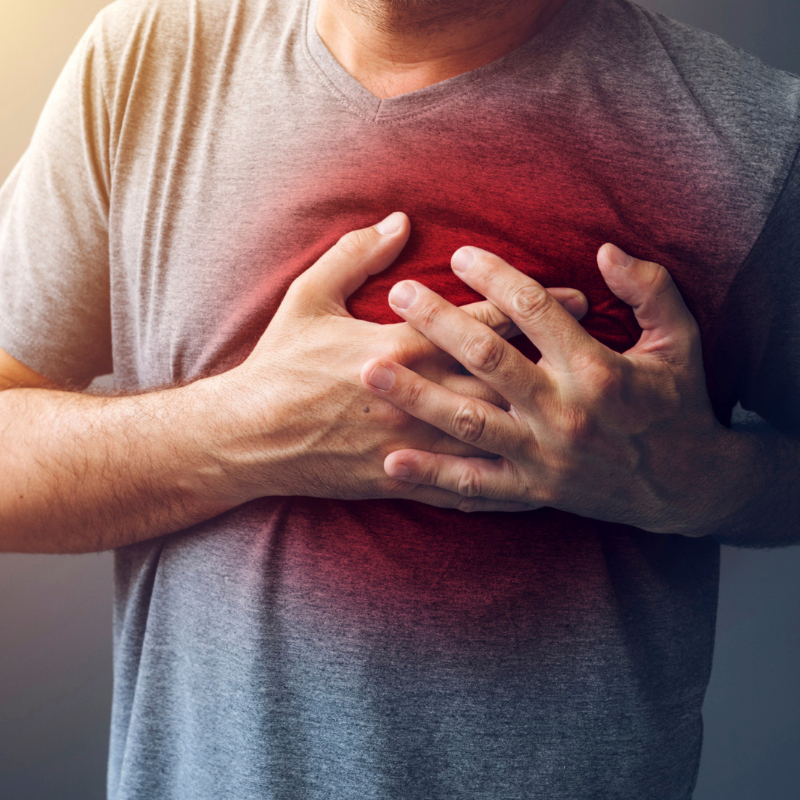Angina

The facts about angina prevalence coming from various studies are often different one from another. It is estimated that nearly 10 million of the USA citizens have this disorder, and every year more than 500 000 new cases are being diagnosed. About 18% of heart attacks are preceded by angina. Around 70% of angina patients are 40 – 60 years old males while in women it occurs later in life. Female patients are between 65 – 75 years old in most cases. The prevalence of angina which is increasing in third world countries is alarming.
Pathophysiology
Angina represents a pain or pressure in the chest, and it is the main symptom of ischemic heart disease. This happens mostly due to atherosclerosis (rarer by some other factors such as hyperthyroidism, left heart hypertrophy) because oxygen supply to the heart is inadequate. Atherosclerosis begins with elevated low-density lipoprotein (LDL) levels that accumulate in arteries where there are being oxidized. After the oxidation process, they initiate the inflammation causing leukocytes to gather. Leukocytes transform oxidized lipoproteins into large foam cells after they penetrate through the arterial wall.
Foam cells stimulate endothelial smooth muscle cells to proliferate, migrate into the inner arterial structure, producing collagen and elastin by various mediators.Now the atheromatous plaque is formed consisting of a lipid layer in the middle, and outer cap made from collagen and elastin. The process of atherosclerosis begins in adolescence, and it is progressing slowly but persistently. At first, an only small lumen of the artery is obstructed letting the blood to flow normally, but over the time it enlarges more and more until it disrupts the blood flow to a measure of causing a severe pain known as angina (angina pectoris).
Risk factors
Risk factors for angina include:
- Age and sex – Angina is more common in male population and older people.
- High blood pressure – Hypertension increase atheroslcerotic changes significantly.
- Dyslipidemia – High LDL and low HDL affect the progress of atherosclerosis.
- Genetic factors – Family history of the angina increases the chance for development of this disease.
- Diabetes – Insufficient production or inability to respond to insulin speeds up the atherosclerosis.
- Stress – Stress hormones that are released propagate atherosclerosis. Stress elevates the blood pressure also.
- Obesity – Obesity is connected to high cholesterol levels. The heart needs more oxygen to work harder and to pump the blood to an overweight body.
- Smoking – Nicotine causes blood vessel constriction. Carbon monoxide occupies the oxygen’s place and interferes with its distribution.
Stable angina

Stable angina pectoris is the type of angina which is characterized by a larger but stable atherosclerotic plaque in one or more coronary arteries. Because the blood supply is lowered, the organism creates new small arteries that are connecting big ones, and they are called the collateral arteries. Collateral arteries can regulate the blood demand of heart while the body is resting, but if physical activity or emotional stress occur they fail to substitute main functionality. Angina happens when more than 75% of arterial lumen is obstructed.
Common symptoms are chest pain or pressure which expands into the neck, arms, and back after physical activity or emotional distress, lasting for about 3 – 5 minutes. It passes after relaxing or after taking nitroglycerin. In diabetics and women, symptoms are differently manifested through confusion, paleness, tinnitus, fatigue, vertigo, shortness of breath, and loss of consciousness. If the pain is lasting longer, and it does not go away after 3 doses of nitroglycerin given in time range between 5– 10 minutes for a single dose, call emergency immediately.

Classification of stable angina by Canadian cardiovascular society:
- Class I Ordinary physical activity does not cause an angina. Angina is present in strenuous, rapid or prolonged activity
- Class II Mild limitation in ordinary physical activity. Angina is present while going uphill or up the stairs, during the fast-paced walking, after physical extortion, after a meal, in cold weather, on the wind, when under emotional stress, or during the first few hours after awakening
- Class III Significant limitation in ordinary physical activity. Angina is present after walking for one or two blocks on the ground or during the climbing up the stairs with a normal pace on normal conditions
- Class IV Inability of performing any physical activity without a discomfort; angina at rest
Diagnosis
Diagnosis of angina is based on medical history, laboratory tests, angiography, electrocardiogram (ECG), echocardiogram, cardiac stress test, and X-ray
Blood tests
After the full medical history, blood tests are first to be done. Complete blood count, blood sugar, hemoglobin, complete lipid profile, C-reactive protein (CRP), and Brain natriuretic peptide (BNP) tests are needed.
Electrocardiogram (ECG)
ECG gives us a look at the electrical activity of the heart. In most cases, it’s normal in rest, but a certain pattern may be seen. It is best to conduct this examination while angina pain is active thus making the evaluation of heart ischemia more precise.
Echocardiogram
Echocardiogram or heart ultrasound is needed to estimate the damage of heart muscle that may have been done and to localize which arteries are affected.
X-ray
Chest X-ray gives a picture of heart’s volume. It is needed to show other problems which are related to the heartbeats.
Coronary angiography
Although invasive, it remains the best method for diagnosing angina. It is used to examine the inside of heart and blood vessels via catheterization.

Cardiac stress tests
It is done on a treadmill or stationary bicycle because better results are given when the heart is working generally. Forced physical activity is needed as far as the symptoms are shown. Until that, ECG, heart frequency, and blood pressure are being watched. If a patient is unable to perform physical extortion, heart work may be induced by medicines.
Treatment
Non-pharmacological measures
Like in all other cardiovascular diseases, lifestyle changes are very important. Don’t let angina to control your life, do slower paced exercises according to your possibilities, walk a bit more or just stretch out except if your doctor told you to strictly rest. Try to lower your weight, especially if you have hypertension, diabetes or dyslipidemia, because all these disorders are worsening atherosclerosis, and they need to be treated.
Avoid eating large meals, saturated and trans fats, fried food, fizzy drinks, and look forward to whole grains, fruits, vegetables, and nuts. Stop smoking. Nicotine affects your cardiovascular system on many levels, and smoking is generally very bad for your organism. Avoiding stress is hard, but stress relieving techniques exist and they can help. Limit your alcohol intake to two drinks or fewer per day if you’re male, and to one drink or less if you’re female.
Pharmacological measures
The goal of pharmacological therapy is to lower the symptoms and heart ischemia as well as to prevent the heart attack.
Nitrates

Short-acting nitrates (nitroglycerin) are used in acute angina attack. Nitroglycerin is given in sublingual tablets or in form of a spray. Its effects are seen after 1 – 2 minutes. They last for up to 60 minutes so nitroglycerin is sometimes used before planned physical exertion. While predominantly widening the veins, lowering the preload (the amount of blood that is coming into the heart), nitroglycerin also has an effect on arteries thus lowering hearts afterload (a resistance the heart has to empower to pump the blood into circulation). This regulates the disbalance between heart’s oxygen demands and it’s ischemic arteries. Nitroglycerin boosts the collateral arteries and reduces the coronary spasm. Long-acting nitrates are given in ischemic episodes prevention.
Beta blockers
Beta blockers antianginal activity comes from their effect on the sympathetic neural system. They are lowering the heart’s oxygen demands by binding to β1 receptors blocking the epinephrine effect on them thus decreasing heart contractions, heart rate, and blood pressure. The perfusion in ischemic zones may be regulated with prolonged diastole. Their dose is adapted to keep heartbeats in a range between 50 – 60 beats per minute.
Calcium channel blockers
Calcium channel blockers selectively block the Ca2+ L type channels in heart and blood vessels. Effects of these medicines are more significant on arteries than on veins. In the heart, they are decreasing the heart rate and heart muscle contractility hence lowering the blood pressure.
Ivabradine
Ivabradine lowers the heart rate prolonging the diastole thus lowering the oxygen demand. This medicine is used in people who can’t use beta blockers.
Ranolazine
Ranolazine lowers the heart contractility and is used as an additional therapy in people with intolerance to other drugs.
Trimetazidine
Trimetazidine blocks fatty acid oxidation enhancing the glucose oxidation lowering the oxygen consumption in an ischemic cell.
Nicorandil
Nicorandil is a coronary vasodilator with a mechanism of action similar to nitrates, but it is reported that it’s effective in cases where nitrates weren’t due to a cardioprotective effect on K+ channels.
Acetylsalicylic acid (Aspirin)
Acetylsalicylic acid is recommended in all types of ischemic heart diseases if it’s not contraindicated. It blocks an enzyme called cyclooxygenase which is responsible for the synthesis of thrombocytes. By doing that a chance for blood clotting to occur is lowered, the flow through the arteries is eased, and the chance for a heart attack is reduced.
Statins
Statins are drugs used to reduce cholesterol. Aside from lowering the LDL cholesterol, they have a cardioprotective effect hardening the fibrous cap on an atherosclerotic plaque which is very important because it’s preventing stable angina to progress into unstable angina. Statins regulate endothelial function, they have an anti-inflammatory effect, while also reabsorbing the cholesterol from atherosclerotic plaque.
Supplements
Coenzyme Q10
Coenzyme Q10 is produced naturally in the human organism, but this ability decreases after the thirties, and that leads to a reduction in organism’s energy processes causing heart failure, arrhythmia, angina, heart attack, and high blood pressure. The production of coenzyme Q10 in the organism is not lowered if it’s ingested via food after the supplementation.
Ginger
Ginger is famous for its effects on circulation. The active substances from ginger are dissolving the fibrin, the protein which is involved in blood clotting and which is causing the circulation disorders. This protein is forming a net, creating a thrombus which can lead to heart attack.
Hawthorn
Hawthorn has substances that are acting like antioxidative agents while reducing the risk of atherosclerosis. They are preventing cholesterol bulking, and they help in cholesterol elimination. After a while, blood vessel elasticity is increased, and circulation is enhanced.
Omega 3 fatty acids
Omega 3 fatty acids may lower the chance for a stroke or heart attack. They are lowering the cholesterol and triglyceride levels decreasing the blood pressure.
Unstable angina
Unstable angina pectoris is a type of angina with more dangerous atherosclerotic plaque. It may be smaller than the one in stable angina, but it has a large number of lipids, and its fibrous cap is thin, insufficient in collagen and elastin so it ruptures easily. Because of the high concentration of inflammatory cells, thrombocytes are lured easily forming aggregates afterward the thrombus is made.
When it obstructs the coronary blood vessel completely but shortly, or the obstruction is significant but incomplete, that state is called unstable angina. If the blood flow isn’t restored a heart attack may occur. Severeness of pain is the same as in myocardial infarction lasting longer than 20 minutes, and it does not vanish after taking nitroglycerin. Both unstable angina and myocardial infarction are part of acute coronary syndrome so it is important to distinguish these two conditions in the health center and treat it accordingly.
Variant angina
Spasm of coronary arteries affected whether with or without atherosclerosis that occurs leading to chest pain is considered variant angina. This pain is usually felt in the morning or after falling asleep, and it’s almost never induced by physical activity or emotional pain. It fades spontaneously or after taking the nitroglycerin.
